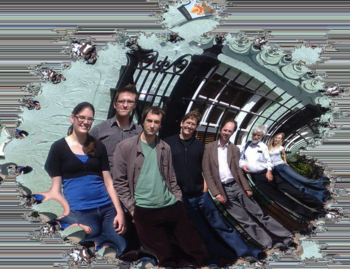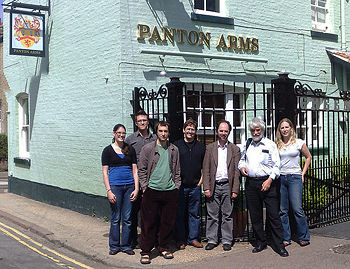User talk:Thomas Wright Sulcer/sandbox7

Once some data were released into the Public Domain, any reuse or modifications are permitted, as illustrated with this image of the drafters of the Panton Principles: It was obtained by transforming the original photo of the drafters of the Panton Principles in front of the Panton Arms pub. With legal claims to the source being waved to the maximal extent possible, community norms are invoked for usage guidance, with proper attribution and documentation being the most essential ones within the scientific community.
The Panton Principles (sometimes abbreviated as PP) are recommendations for scientists on a simple standard notification to be attached to scientific data that are released to the public. The notification states, in effect, that other scientists can use the data without worrying about copyright issues. The idea is to promote sharing of scientific data. The name is derived from the Panton Arms pub in Cambridge, UK, which was the location where the principles were originally drafted.
Background
Scientific data is different from other types of information such as encyclopedia articles in Citizendium or government census information or pictures on Flickr or baseball statistics or patterns of Internet searches such as SERP results. Since scientific data can help advance human knowledge, it enables valuable breakthroughs which may, in turn, lead to new technologies or capabilities. A spreadsheet of numbers may reveal a cure for cancer or a way to build a vehicle which defies gravity or reveal how to decipher an ancient language.
But scientists may have reasons to withhold or delay the release of data. They may need time to investigate data fully to prevent valuable information from being overlooked. It's possible, as well, that a scientist may selectively pick and choose data which supports a given conclusion while ignoring outliers, perhaps to make a case for a specific hypothesis. In such an instance, revealing the entire data set may allow other researchers to use their own data to prove them wrong. At the same time, scientists have great leeway in determining when, how, and whether to release their findings.
And a scientist may have concerns about how data will be used after it is released. It's possible that it could be re-used for unethical purposes such as making dangerous weapons or chemicals, or re-purposed to some new task unintended by the original data collector. Scientists, like all academics, are under pressure to publish their results and build their reputations by adding to the storehouse of human knowledge. Will their data be used for a future project which wins plaudits for future researchers who fail to acknowledge the original contribution? Generally, however, at some point, scientists must release their data to maintain credibility in the scientific community, because this allows peers to check their methods and see if it's possible to replicate their results. It is factors such as these which led to the declaration.[1]
Principles
Accordingly, for a variety of reasons, some scientists withhold their data. Further, scientists coming across data which is in the public sphere may face uncertainty about whether they are allowed to access it, use it, study it further, or base new studies on it. It is enough of an issue that many scientists issued a statement known as the Panton Principles.
Generally the principle of validation makes it necessary to reveal data as a matter of accepted practice. This allows other scientists to replicate the original results by conducting independent follow-up studies to see if the original conclusions are valid.
What the drafters of the Panton Principles are suggesting is that when scientists release data, they attach a statement or marker which describes their wishes regarding the future use of the data. The idea is to come up with an easily understood tag applicable to all data they choose to release, so that others who come across the data will be able to understand what the data creator's intentions were when releasing the data. The hope is, of course, that all data might be freely used for any purpose, but the tag enables this to be more readily understood.
There have been concerns that current license formats such as the Public Domain Dedication and License (PDDL) and the Creative Commons CC0 are complex. And the movement favoring the Panton Principles is, in some respects, a way to simplify matters. One scientist explained that the benefit of declaring data "open" is that it makes it possible for subsequent researchers to use it freely, without fear or anxiety or uncertainty:
The biggest danger is NOT making the assertion that the data is Open. There may be second-order problems from CC0 or PPDL but they are nothing compared to the uncertainty of NOT making this simple assertion. Do not try to be clever and use SA, NC or other restricted licenses. Simply state the data are Open.[1]
Blogger Walter Jessen explained:
Science is based on building on, reusing and openly criticising the published body of scientific knowledge. For science to effectively function, and for society to reap the full benefits from scientific endeavours, it is crucial that science data be made open. By open data in science we mean that it is freely available on the public internet permitting any user to download, copy, analyse, re-process, pass them to software or use them for any other purpose without financial, legal, or technical barriers other than those inseparable from gaining access to the internet itself. To this end data related to published science should be explicitly placed in the public domain.[2]
In March 2010, the Panton Principles is an Internet-based initiative calling for scientists to make an "explicit and robust statement" regarding his or her wishes for the data by using a "recognized waiver or license that is appropriate for data."[3] The call for a set of principles stems in part from a sense that "many widely recognized licenses are not intended for ... data". Licenses such as "Creative Commons" have been described as unsuitable for handling issues such as scientific data.[4]
An Internet search of major newspapers and magazines, including the New York Times and BBC News using the search term "Panton Principles" did not find any results on March 23, 2010, although there are Internet sites dealing with scientific issues that have posted comments about the initiative.
- When publishing data make an explicit and robust statement of your wishes.
- Use a recognized waiver or license that is appropriate for data.
- If you want your data to be effectively used and added to by others it should be open as defined by the Open Knowledge/Data Definition – in particular non-commercial and other restrictive clauses should not be used.
- Explicit dedication of data underlying published science into the public domain via PDDL or CCZero is strongly recommended and ensures compliance with both the Science Commons Protocol for Implementing Open Access Data and the Open Knowledge/Data Definition.
Why are the principles necessary? A post-doctoral student in Sweden explained in a blog about being perplexed when finding useful data but without any explicit information about what could be done with it. Contacting the creators of the data for permission is cumbersome and slow, and there is the possibility that the initial author of the data is "missing in action". An explicit statement is much preferred.[5] But the idea about using a "waiver or license appropriate for data" was, in the view of this blogger, "debatable", particularly when it came to the possibility of mixing data sets, and prefers the copyleft license approach. He didn't like the non-commercial restrictive clause since, in his view, it doesn't make things easier, and prefers public domain via the PDDL or CCZero licenses.[5]
One source credits the launch of the Panton Principles to Jonathan Gray.[6] Cameron Neylon described how the principles came about:
The Principles came out of a discussion in the Panton Arms a pub near to the Chemistry Department of Cambridge University ... Where we found agreement was that for science, and for scientific data, and particularly science funded by public investment, that the public domain was the best approach and that we would all recommend it. ... placing data explicitly, irrevocably, and legally in the public domain satisfies both the Open Knowledge Definition and the Science Commons Principles for Open Data was something that we could all personally sign up to. The end result is something that I have no doubt is imperfect ... Above all, it is a start.[6]
References
- ↑ 1.0 1.1 petemr's blog. The Panton Principles: A breakthrough on data licensing for public science?, Unilever Cambridge Centre for Molecular Informatics, 2009-05-16. Retrieved on 2010-03-23.
- ↑ Walter Jessen. The Panton Principles for Open Data in Science, Next Generation Science, February 19, 2010. Retrieved on 2010-03-23.
- ↑ Bill Hooker. Panton Principles for Open Data in Science, Science Commons Symposium, 2010-03-23. Retrieved on 2010-03-23.
- ↑ The Panton Principles for Open Data in Science. Connected Knowledge (February 19th, 2010). Retrieved on 2010-03-23. “Many widely recognized licenses are not intended for, and are not appropriate for, data or collections of data. A variety of waivers and licenses that are designed for and appropriate for the treatment of data are described here. Creative Commons licenses (apart from CCZero), GFDL, GPL, BSD, etc are NOT appropriate for data and their use is STRONGLY discouraged.”
- ↑ 5.0 5.1 Egon Willighagen. Panton Principles, Egon Willighagen's Blog, February 19, 2010. Retrieved on 2010-03-23.
- ↑ 6.0 6.1 Cameron Neylon. The Panton Principles: Finding agreement on the public domain for published scientific data, Science in the Open (blog), 22 February 2010. Retrieved on 2010-03-23. “The launch of the Panton Principles, many months after they were first suggested is really largely down to the work of Jonathan Gray. This was one of several projects that I haven’t been able to follow through properly on and I want to acknowledge the effort that Jonathan has put into making that happen.”

